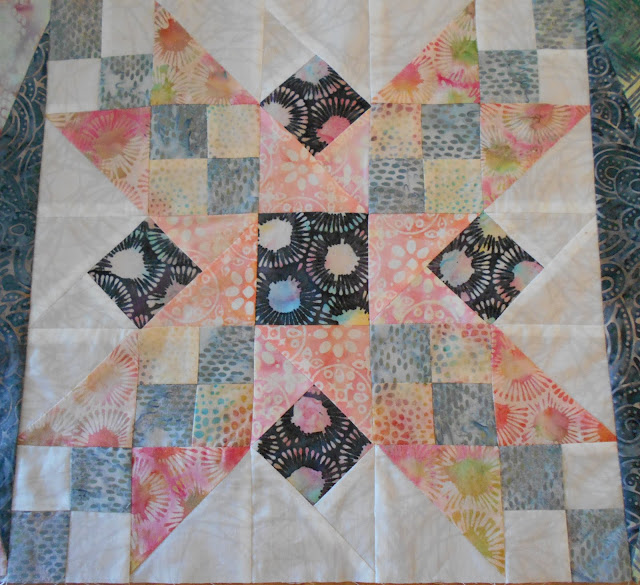I started laying out the 4-patch squares and I soon remembered that I had made the squares during the very first week. At that time I didn't have a feel for where this project was going and I only used four or five neutrals. In Week One I only made half the number of pieces I needed, and I told myself I could always buy more neutrals to use for the rest of the little squares once I had a better idea of what I wanted to do.
As I started to lay out the little 4-patch blocks "randomly," I realized that 1) I now had several additional neutrals, 2) none of the new neutrals were going to be in the 4-patch blocks because I made the half-square triangles before I bought the additional neutrals, and 3) if I didn't make some more half-square triangles right away, using my new neutrals, my blocks would not be random and might not look right.
So the first detour was to cut out a lot more triangles and sew them together into gray + neutral squares.
The second detour was forgetting that I needed to cut the triangles with the strips with the RIGHT SIDES TOGETHER because I didn't LOOK AT THE DIRECTIONS because I can remember how to do something I did four weeks ago, right? I ended up with all my neutral triangles going one way and my gray triangles going the same way, which meant that when I put them right-side-together they didn't match up. So, I cut some more. Adagio! Slow down!
Then I substituted some of the new squares in the 4-patch blocks which I had laid out. With this much effort going into it, it's not truly random, but I was really going for more of an "evenly dispersed" look. I wanted most blocks to have some of the original neutrals and some of the newer neutrals. I wanted to avoid having a large number of blocks with only the original neutrals. The original neutrals were all very subtle, tone-on-tone mostly. The newer fabrics were a little more "daring," if you know what I mean. Thus, it would be really obvious, I think, if I didn't spread the wealth around.
Third detour: When I finally started making the 4-patch blocks, my machine started eating them. Lots of stopping and ripping out. I changed to my straight-stitch needle plate. That helped, but it doesn't completely avoid the problem. I googled "sewing machine eating fabric and I found a great list of things to try HERE. I like the idea of using a scrap of fabric to get started.
Fourth detour: I sewed five sets of squares together and stopped to check them out. Ooops. I did not pin them before I sewed them and I had a lot of slippage on all five pieces. Thanks to Becca I now know that it is legal to throw bad pieces away and just make new ones, but I don't want my seam ripper to get rusty or something, so I think I'll just do this the hard way.
A detour from the detours:
Before going further, I would like to share another photo (from our trip to Italy) that resembles the pieces we are making this week. This was taken in Pisa. I think one of Bonnie's photos was taken at the same building, but from a different angle.

I finally got the hang of this week's "assignment," and now I have half of my pieces done.

I did the Stitch and Flip part, and it worked the first time! Amazing!

This is probably all I'm going to do this week because I am getting ready to go on vacation and I have lots to do. I don't know if I'll have time to do anything on Week Six before we leave, but I'll try. I'm really sorry to have to miss the rest of the quilt-along. I'm looking forward to seeing photos of everyone's progress.
Before I go, here is the link to Mystery Monday Link-Up Part 5. It is really fun to see what fabrics others have chosen. I have yet to see ANY of my fabrics used by anyone else.








































